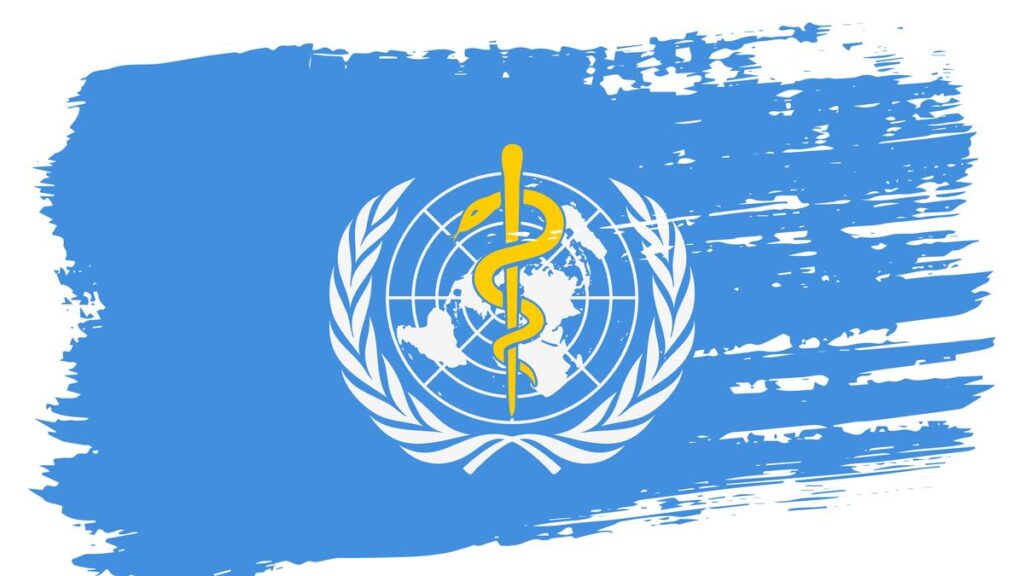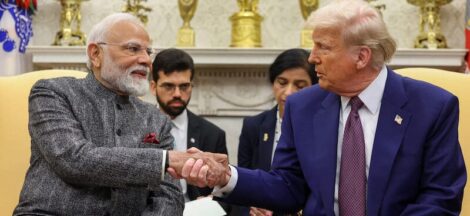By Kashish Aneja, Lawrence O. Gostin
This year’s World Health Day falls against the backdrop of strained multilateralism and a crisis in global health funding. World Health Day serves as a stark reminder that good governance, sustained financing, and collective action are essential to safeguard public health worldwide. It is crucial, at this juncture, to reflect on the United States planned withdrawal from the World Health Organization (‘WHO’) and dismantling of the US Agency for International Development (‘USAID’).
The WHO was established in 1948 as a major arm of the United Nations. Its constitutional mandate is to serve as the leading international health agency responsible for tracking disease outbreaks, coordinating global efforts to combat diseases, and strengthening health systems. It plays a crucial role in pandemic preparedness and response. The WHO led the eradication of smallpox and is on the verge of polio eradication. Its Expanded Immunisation Program (‘EIP’) has protected children against vaccine preventable diseases like measles.
It was born with constitutional powers to negotiate health treaties and regulations, such as the Framework Convention on Tobacco Control and the ongoing Pandemic Treaty negotiations, and it continues to update International Health Regulations (‘IHR’), as seen with the recent major amendments adopted on June 1, 2024. The agency’s primary job is norm-setting, scientific standards, and technical assistance. It plays a leading role in disease classification and synthesis of the best evidence around treatments. WHO also plays a unique coordinating role in responding to health emergencies such as novel outbreaks of Ebola, Marburg, and Mpox.
There has been, at least seemingly, a strong norm regarding the importance of international cooperation in health since WHO’s creation. That is, until now.
President Donald Trump has notified the WHO of the US’s intent to withdraw from the WHO within a year. His administration has also severely cut international development assistance for health, while dismantling USAID. As the United States has effectively withdrawn from global health engagement, the future of international solidarity led by the WHO is at risk.
For over 75 years, the US has sustained this status through its commitment to driving programs that tackle pressing global health issues. It has been a principal funder and a major driver of the WHO’s agenda. Notably, in the 2022-2023 biennium, the U.S. contributed $1.284 billion to WHO, which was 20 percent of its budget, surpassing contributions from other major global health stakeholders including the Gates Foundation, Gavi, and the European Union. This funding supports emergency response, childhood vaccinations, and disease eradication, among many others.
The US has spearheaded the fight against Ebola outbreaks in West Africa, been the major funder for HIV/AIDS prevention and treatment through the President’s Emergency Plan for AIDS Relief (PEPFAR) and the Global Fund. In 2023 alone, US’s global funding constituted nearly three-quarters of international development assistance for HIV/AIDS, 40 per cent for malaria, and more than a third of the funding to combat tuberculosis. Since its formation in 1961, USAID has been instrumental in saving lives during various global crises. USAID has provided life-saving prevention and treatment for diseases like HIV and polio in the world’s poorest countries.
Other key US global health initiatives include the President’s Malaria Initiative (‘PMI’), support for Gavi, the Vaccine Alliance, the Global Fund to Fight AIDS, Tuberculosis and Malaria, and the Global Health Security Agenda (‘GHSA’). US has not only provided financial support but has also been a key player in international health diplomacy, as demonstrated by its role in driving the successful IHR negotiations in 2024, and the Declaration of Alma-Ata. American scientists, institutions, and public health experts have been key in shaping WHO policies, advancing research, and guiding responses to outbreaks.
On January 20, 2025, President Trump announced that the US would withdraw from the WHO, echoing a previous move in 2020 that was reversed by President Biden. The stated reasons for the withdrawal include the WHO’s mishandling of the COVID-19 pandemic, failure to adopt urgently needed reforms, inability to demonstrate independence from member states’ political influence, and unfairly onerous payments demanded from the US compared to other countries like China.
This withdrawal led to a pause in the transfer of vital US funds, support, and resources to WHO, including the pulling back of US officials from the Pandemic Treaty negotiations. Personnel of US’s Centre for Disease Control and Prevention seconded to WHO were withdrawn, and the CDC was banned from communicating with WHO.
Moreover, the US government is in the process of dismantling the USAID; specifically, it has issued a stop-work order for USAID-funded projects, including those in India, effectively halting critical programs that support disease surveillance, vaccination drives, maternal and child health, and pandemic preparedness. Recently, the US Supreme Court ordered the Trump administration to pay all of USAID’s current financial obligations. But a trial court subsequently ruled that the administration could still cancel all future contracts and funding.
All of this marks a shift in global health governance, moving away from a long-standing era of US leadership and international cooperation. This disengagement threatens to weaken international cooperation at a time when the world is implementing lessons learnt from the COVID-19 pandemic and preparing for future ones. It risks undermining global pandemic preparedness by disrupting mechanisms for addressing transnational health threats. The withdrawal also weakens the WHO’s financial stability and operational capacity, particularly in Low- and Middle-Income Countries (‘LMICs’).
President Trump cited the organisation’s mishandling of the COVID-19 pandemic and other global health crises as a key reason behind withdrawing from the WHO. He also claimed the WHO failed to adopt urgently needed reforms and demonstrated an inability to be independent of the inappropriate political influence of WHO member states. Trump’s administration believed the WHO continues to demand unfairly onerous payments from the US, far out of proportion with other countries’ assessed payments. They pointed to China’s lower contribution despite having a much larger population as evidence of this imbalance.
The withdrawal reflects a broader isolationist stance prioritising national interests over global collaboration. This aligns with Trump’s “America First” approach, which includes a sharp decline in international health funding.
Concerns were raised by the current administration about the WHO’s failure to adequately obtain, vet, and share information in a timely and transparent fashion during the COVID-19 pandemic and its perceived lack of independence from China. The inability to definitively determine the origins of SARS-CoV-2 caused strains in US relations with both China and WHO. The Trump administration has also held concerns regarding the inefficient management of WHO’s budget and finances.
The US is uniquely positioned in its legal authority to withdraw from the WHO. According to the WHO’s constitution, the US is the only country permitted to withdraw its membership. However, this right is conditional on a 1948 joint resolution of the US Congress. This resolution stipulates that the US must give the UN one year’s notice of its intention to withdraw and pay its existing debts to the agency.
The US withdrawal threatens WHO’s financial stability, as the US has historically been IT largest donor, contributing 20 PERCENT of its budget in 2022–2023. President Trump also paused the transfer of vital US funds, support, and resources to WHO, including membership fees. This makes matters more acute, jeopardising vital WHO-led health programs including polio eradication, pandemic preparedness and response, and universal health coverage.
The freeze on USAID funding, as well as foreign-aid programs such as PEPFAR, has far-reaching implications for public health initiatives globally, particularly in LMICs, including India, that have historically benefited from USAID support in areas such as tuberculosis eradication, HIV/AIDS prevention, maternal and child health, neglected tropical diseases and healthcare infrastructure strengthening. Critical programs for global health security, including disease surveillance for emerging infectious diseases, are also impacted. Thousands of health workers in countries like Kenya and Ethiopia have reportedly been affected by the shutdowns. The freeze has impeded responses to outbreaks like Ebola in Sudan and Uganda, and Marburg in Tanzania, where USAID had previously played a coordinating role.
The withdrawal creates institutional uncertainty for the WHO, forcing drastic cost-cutting measures and budget cut proposals. The organisation is concerned about facing a “hand-to-mouth type situation” if US funding is lost. The concurrent suspension of USAID financing and exit from WHO undermine global trust and collaboration and upend current health initiatives, leaving impacted nations and organisations with little time to adjust.
The US withdrawal weakens the international system of global health cooperation and undermines global pandemic preparedness. It not only impacts countries across the globe but also invites significant disadvantages for the US. It decreases real-time access to disease surveillance, technical guidance, and early warning networks for the US. It also reduces US influence and leadership (‘soft power’) in the world on global health issues. The US would not be at the table as the World Health Assembly continues to negotiate global health law and policy reforms.
The withdrawal forfeits US influence in revising the International Health Regulations and shaping the Pandemic Accord, both essential for enhancing global preparedness and coordinated response to emerging health threats. The focus on short-term financial gains also overlooks how weakened WHO-led initiatives can drive cross-border health risks that may inevitably threaten US citizens. Outbreaks in any part of the world can find their way to the US, causing new flare-ups.
LMICs will be disproportionately harmed, as they rely on coordinated global mechanisms for access to vaccines and therapeutics and have weak health systems and scarce resources. This withdrawal has exposed how LMICs are often kept in a cycle of dependency on external support, making them vulnerable to sudden shifts in donor priorities. It erodes trust between nations and organisations committed to combating infectious diseases.
It also creates a leadership vacuum that other nations, like China and India, and blocs such as the BRICS nations, may seek to fill; although it seems very unlikely that any one of them can singularly do so. This could lead to a realignment of global health governance with a more multipolar system. China, India, and other nations might be willing to take on a greater leadership role in global health governance, including within the Pandemic Treaty negotiations. South Africa and Brazil could play larger roles, given their recent hosting of the G20 and COP30, respectively.
While China has historically donated little to WHO beyond its fees and recently opposed increases in assessed contributions, it may increase its influence by filling personnel vacancies at WHO and expanding support for health programs through bilateral partnerships, but only to build influence with strategic partners. China might selectively step in to take over projects where the US freeze has caused abrupt halts; it is already providing increased funding in Southeast Asia. Historically, China has engaged bilaterally in global health, principally through its Belt and Road Initiative. At the same time, China has not been a robust funder of multilateral institutions like the WHO, and that is unlikely to change.
The EU has traditionally supported multilateral health efforts, such as through the European and Developing Countries Clinical Trials Partnership. Other European donors, like Germany and the UK, are significant contributors to the WHO, though their individual contributions are much less than the US. However, many European donor countries have recently announced foreign assistance cuts and may be unable to fully compensate for the US funding gap. The EU and its member states, being collectively the world’s largest Official Development Assistance provider, might selectively increase funding in critical areas like health and climate change in direct dialogue with affected partner countries.
Organisations like the Bill & Melinda Gates Foundation are already major contributors to global health initiatives, including the WHO. The Gates Foundation has indicated it might need to decide if and how it can keep programs like polio eradication and malaria fighting on track due to the US pullback. The Foundation has also clearly indicated that it will not be able to fill the overall funding void. While philanthropic organisations can mobilise resources and fund innovative ideas, heavy reliance on them raises concerns about accountability, priority-setting, and potential conflicts of interest. Private donors might prioritise diseases and regions based on their interests, potentially neglecting other urgent needs.
With the US reducing engagement, India can work with like-minded countries to drive reforms at the WHO, including advocating for improved financing mechanisms. India has deep historical and economic ties with Africa, Latin America, and Southeast Asia and can expand South-South cooperation through collaborative research, regional vaccine hubs, and capacity-building programs. India’s large-scale vaccine production capacity, particularly through the Serum Institute of India, positions it as a key player in global health.
Countries in the Africa Group are indicating a willingness to step up, with some nations and partners pledging increased funding to WHO. Regional organisations like the African Union and the Association of Southeast Asian Nations can play a greater role in coordinating health efforts within their respective regions. Some LMIC leaders are emphasizing the need to move beyond aid dependence and focus on self-reliance and domestic resource mobilization.
The US withdrawal and funding freeze also suggest a potential shift towards prioritising bilateral cooperation and potentially tying aid more closely to geopolitical interests. The administration might selectively restore funding to multilateral entities perceived as advancing US national interests. In essence, while other actors are attempting to respond to the potential void left by the US, and a shift to bilateral funding might offer some perceived advantages in direct control, it carries significant risks for the coherence, effectiveness, and equity of global health efforts. These risks include fragmentation of global health efforts, potentially creating gaps and overlaps in efforts and increased administrative burdens, reduced political buy-in from other nations for global initiatives, potentially weakening their effectiveness, and undermining of international norms and standards.
The WHO Pandemic Treaty, which remains under negotiation by the Intergovernmental Negotiation Body and will enter its final leg of negotiations later this month, aims to improve global coordination and ensure equitable access to medical countermeasures during health crises. It is an ambitious attempt to address the systemic failures revealed by the COVID-19 pandemic, including a lack of preparedness in countries and a fragmented global response. The treaty seeks to strengthen pandemic preparedness and response on a global scale. The US has been actively involved in these negotiations and therefore the absence of the US from the WHO, and consequently the Pandemic Treaty negotiations, carries significant implications.
The withdrawal creates new dynamics in the negotiations. First, while the US has acted somewhat as a bridge-maker in the talks, its absence might ironically create a path for consensus on valuable equity measures that the US has opposed, such as unhindered access to pandemic-related health products in an emergency and specifically provisions around Pathogen Access and Benefit Sharing (PABS) and technology transfers. However, the lack of US diplomatic engagement could also hinder the progress and scope of the agreement.
Second, the withdrawal of a major player like the US may also raise concerns about the treaty’s legitimacy and subsequent effectiveness. As a major funder of global health initiatives and a key player in international health diplomacy, its absence from the Treaty could be viewed as a setback for multilateralism and might embolden skeptics, potentially leading other countries to follow suit (Argentina has already announced its withdrawal from the WHO). The WHO itself relies on the cooperation of member states.
Finally, even if a treaty is finalised without US participation, which is the hub of R&D and host to major pharmaceutical companies, the lack of US commitment could weaken its global enforcement and effectiveness.
The potential decline in US engagement in global health, marked by a possible withdrawal from the WHO and funding freezes, necessitates a new paradigm in global health governance. The world cannot afford to let global health fall into crisis because of declining US engagement. The interconnected nature of health threats, as highlighted by ongoing outbreaks and the lessons of the COVID-19 pandemic, demands urgent and coordinated action.
The global community must actively work to reform the WHO – financially, structurally, and politically – to reduce its reliance on any single major donor and ensure its continued ability to coordinate global health efforts. Diversifying funding for global health can also lead to more balanced global health priorities. This is also an opportunity for increased regional collaborations and strengthening of local capacities to enhance disease surveillance, outbreak response, and health system resilience. Self-reliance in public health funding and infrastructure is imperative for long-term sustainability and therefore, countries must prioritise and increase domestic investments in public health initiatives.
Failure to act decisively and strategically in the face of US disengagement risks reversing hard-won gains in global health, increasing health inequities, and leaving the world more vulnerable to future health crises. The time for a concerted global response to safeguard global health is now. (IPA Service)
Courtesy: The Leaflet




 BJP’s Waqf Act Is Nothing But Daylight Land Grab Of Minority Properties
BJP’s Waqf Act Is Nothing But Daylight Land Grab Of Minority Properties 